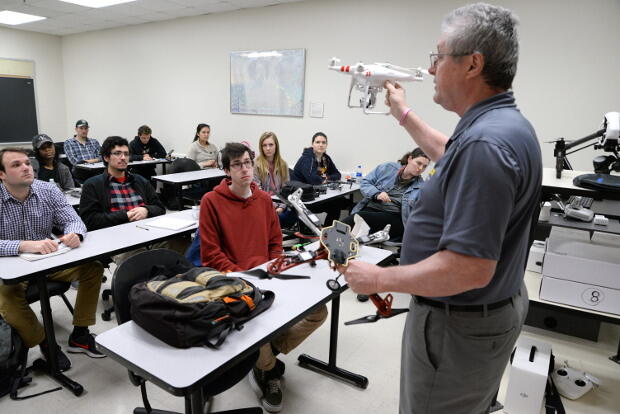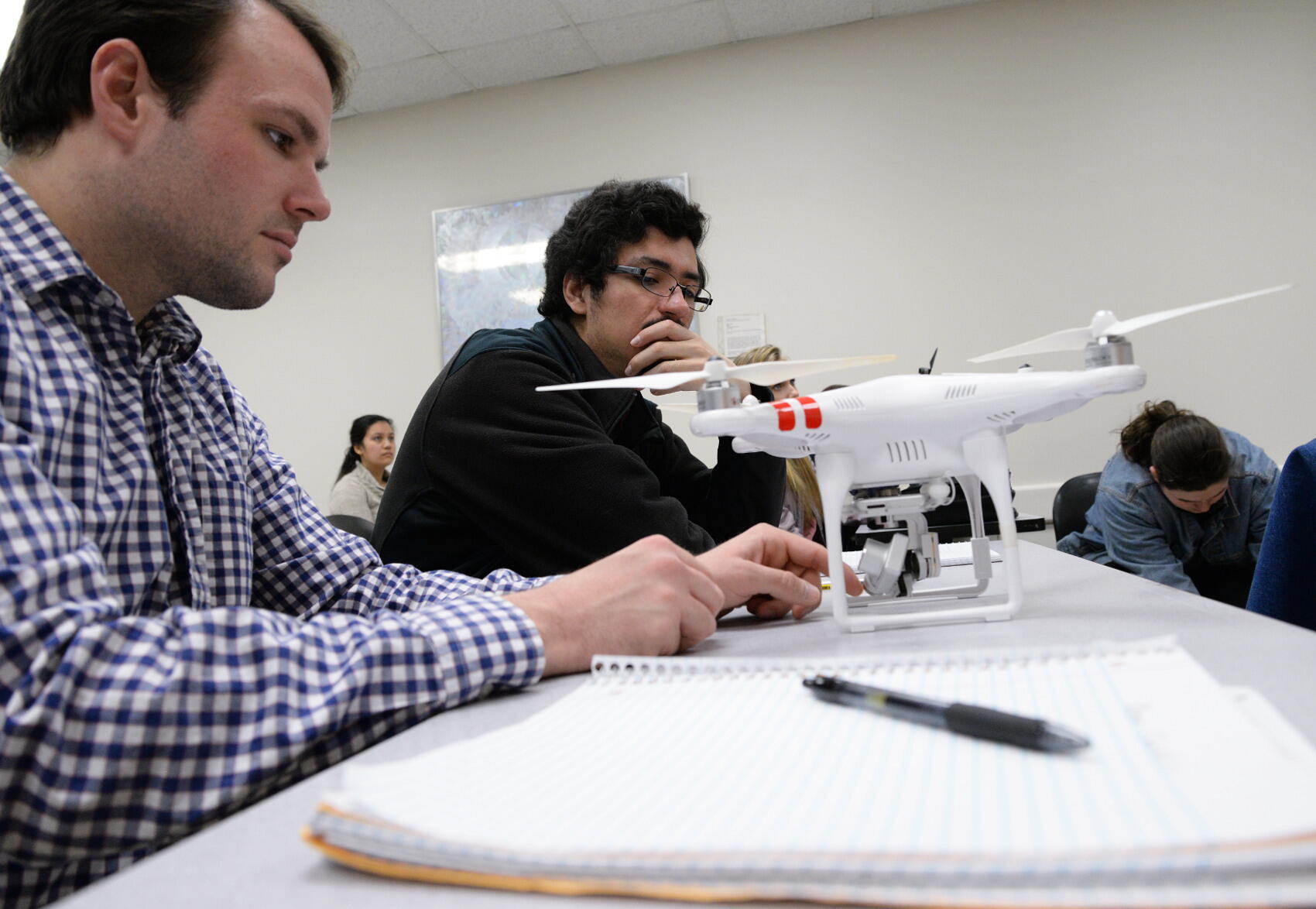
April 9, 2018
New course trains mass communications students to pilot drones
The journalism program of VCU’s Richard T. Robertson School of Media and Culture is one of a small handful nationwide that is giving students hands-on experience with unmanned aerial vehicles.
Share this story
For journalists, sending a drone skyward to cover a news story can provide their audience with otherwise impossible to obtain photos and video.
But piloting a drone safely and legally is more complicated than just buying a quadcopter and launching it into the sky. There are complicated Federal Aviation Administration regulations that dictate where, when and how high drones can fly. And there are thorny ethical and privacy concerns that must be carefully weighed.
A new course at the Richard T. Robertson School of Media and Culture in the College of Humanities and Sciences is helping Virginia Commonwealth University journalism students, as well as other mass communication majors, navigate these issues and prepare them to fly drones for the newsrooms of tomorrow.
“Quadcopters are the hottest thing out there right now in the world of not only journalism but photography and videography,” said instructor Gary Gillam, who is teaching MASC 491-005 Special Topics: Drones. “What once took a helicopter, and the costs of renting a helicopter, has turned into a one-time investment of maybe $1,500. After that initial investment, a photographer has the ability to use the quadcopter over and over again. It’s added a whole new perspective to storytelling that only the networks or highly financed projects could afford.”
VCU’s program is part of an emerging trend nationwide of journalism schools beginning to provide students with hands-on training to pilot drones, also known as unmanned aerial vehicles or unmanned aircraft systems.
“We’re not the first j-school to teach students about drones — Nebraska and Missouri share that honor. But we’re definitely early adopters,” said Jeff South, associate professor of journalism and director of undergraduate studies for the Robertson School.
By the end of the course, South said, the students will understand how to safely fly drones and the storytelling and newsgathering potential they offer.
Drones ... can give you a perspective that you can’t get on the ground.
“Drones are important not only in journalism but also in advertising, filmmaking and other areas of communication because they can give you a perspective that you can’t get on the ground,” he said. “A drone that is a couple hundred feet in the air will give you a completely different view. The aerial photos or videos can greatly enhance the story you’re conveying. Moreover, drones can be used for air sampling and other data collection for possible news stories.”
In the class, the students are learning about laws and ethics and the need for safety associated with flying drones, and they’re receiving hands-on piloting practice in a ballroom in VCU’s University Student Commons, as well as outdoors at the Amelia Wildlife Management Area, thanks to a partnership with the Virginia Department of Game and Inland Fisheries.
Gillam, a licensed drone pilot, is helping the Department of Game and Inland Fisheries with video and other projects using drones. Ron Messina, media manager for the department, said DGIF is interested in acquiring drones in the near future for a variety of uses.

“This is a great opportunity to learn from an experienced, licensed drone pilot,” he said. “For a state agency that manages wildlife, boating and recreational activities, there are so many potential uses for drone technology down the road."
Also as part of the partnership, the department granted permission for the class to practice low-altitude drone flights on select days at the wildlife area, about an hour from Richmond.
“By working together, DGIF and VCU both benefit,” Messina said. “It’s a win-win situation.”
Several students taking the course say they are planning to pursue a Remote Pilot Certificate from the FAA.
“My rugby coach for VCU purchased a drone last fall and he’s been using that to film our games and stuff. I noticed that when he’d put it up in the air, you could get shots of the city that you couldn’t really find anywhere else,” said Jack Laudano, a senior broadcast journalism major. “I thought that’d be a really cool tool to have.”
Laudano saw how useful licensed drone operators could be in modern newsrooms while working part-time at WWBT-TV NBC12 in Richmond.
“I’ve seen how [knowing how to operate a drone] is a valuable tool for someone who’s interested in entering that field,” he said. “If they need someone to go out with a drone for an hour and get certain shots, you can go out and do that.”
Catalina Currier, a sophomore public relations major, took the class because she knew drones could have all sorts of applications.
“We’ve learned about taking photos, taking video, using it for reconnaissance and search-and-rescue for [disasters] like with landslides in California,” she said. “There’s so many applications. With PR, you could use drones for videos, use it to showcase your company.”
The course, in the works for a number of years, was developed by Gillam, South and Tim Bajkiewicz, Ph.D., associate professor of broadcast journalism and associate director of the Robertson School.

“I hope students are seeing just what a big deal drones are now and in the future,” Bajkiewicz said. “They’re getting to be part of everything, not just journalism storytelling or cool video. Agriculture. Engineering. They’re amazing tools and people are finding endless applications.”
The class has heard from several guest speakers, including Alix Bryan, a web reporter for WTVR-TV CBS6, and Ned Oliver, a reporter for the Richmond Times-Dispatch. Both Bryan and Oliver are licensed drone pilots.
“As we’ve heard from our guest speakers, anyone watching news on TV or online has come to expect drone footage,” Bajkiewicz said. “Drones provide perspectives and a sense of engagement that just isn’t possible with other kinds of cameras. Right now, not too many newsrooms and organizations have someone who’s licensed to fly a drone, but that’ll change quickly. Journalists always want fresh and exciting ways to tell stories, and drones do that very well.”
The current course is an extension of an Honors class offered in spring 2015, while the FAA was developing its rules for the commercial use of drones. Unlike this semester’s course, that 2015 class did not have a hands-on component, South said.
“The current class takes drones, literally, to a whole new level.”
The current class is taught as a topics course, but the Robertson School is planning to convert it to a permanent course next year, recognizing that the importance of drones in developing media content will only continue to grow.
“Soon, every TV station in the nation will have at least one pilot. This is a completely new profession for videographers,” Gillam said. “But news is not the only place where quads are being used in the workplace. Farmers are using them to survey their crops. Law enforcement, firehouses, missing person searches, there are a 1,000 places where creative people are integrating quadcopters into their workplace.”
Subscribe to VCU News
Subscribe to VCU News at newsletter.vcu.edu and receive a selection of stories, videos, photos, news clips and event listings in your inbox.













